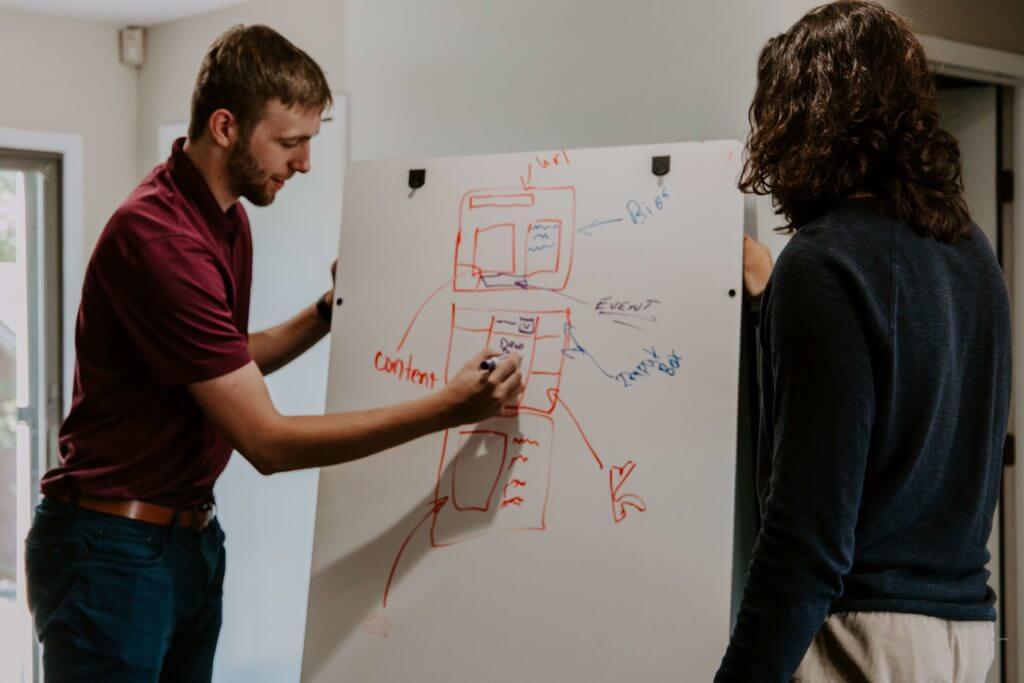Spiral Model SDLC is one of the models used to organize the working process around a software project. Along with Waterfall, Agile, Iterative, V-Shaped. and Bing Bang model, SDLC Spiral model aims at lowering the possible risks and increasing the chances of huge success of the final product in software development. The question is ‘Why does Spiral SDLC Model stand out among the others? What big advantage does it have in its sleeve?
In this article, we are going to analyze the concept of this model, its advantages and disadvantages, as well as discuss in which cases it fits best.
What is Spiral Model?
A Spiral model SDLC represents a highly systematic approach to software development that essentially combines Waterfall and Iterative models. First, let’s have a look at Waterfall and Iterative models to have a better idea of how Spiral works.
Here is how the Waterfall models looks like:
In the Waterfall model, software development is carried out in a linear manner, and the team needs to finish one stage before starting the other. On top of that, the scope is defined before the start of the project on Requirements stage.
The concept of Iterative Model is more complicated. Designed to eliminate the weak points of Waterfall, the model starts with the team specifying and developing only a part of the software product. After, the product is gradually brought to life in iterations, phases with specific tasks and fixed deadlines. With the Iterative model, teams can assess risks at the earliest stages successfully and easily. As a result, there is a slim chance the team will face risks further down the line, if at all.
Typical Iterative model process
Thus, Spiral Model of SDLC takes a gradual approach of Waterfall and the repetitive nature of the Iterative model to make software development more flexible for projects with strict initial scopes. Plus, it enables dealing with risks at any stage.
What Do Spiral Model Phases Include?
Now let’s have a closer look at Spiral Model SDLC and how it works. There are four phases for each development stage:
Planning
At this phase, the team needs analyse the demands to see if they are viable. If they are, the teams starts planning out has the development stage.
Risk Analysis
Here, the team closely accounts for the possible problems that may arise on the stage in question as well as possible ways they would tackle those challenges.
Development
With everything planned out and considered, the experts responsible for the stage start working.
Evaluation
When the stage is finished, the client assess the result and provides the team with feedback.
Whether it development, prototyping or testing, the team goes through each of these phases for every development stage. This is a repetitive process done many times throughout the whole project engineering. This is how SDLC Spiral Model stands out among other models.

Visualize the Process with Spiral Model Diagram
To understand the process better, let us analyze the diagram of spiral model in software engineering:
As we can understand from this diagram, before creating an operational prototype of the project, at least two prototypes are created. Moreover, the development of all the prototypes goes through all the phases of Spiral Model SDLC to ensure all risks are accounted for.
Spiral model process
Given, this model is complicated. Still, thanks to the comprehensive risk analysis, careful planning, and constant step verification, teams can carefully handle the budget, schedule, security, performance, and other risks. Furthermore, the models establishes close and effective interaction between the team and the client’s stakeholders. With Spiral Model of SDLC, it is much easier to meet all client demands, needs, and expectations, as there is continual validation throughout the development process.
What are the Advantages of Spiral Model?
We have already examined the way Spiral SDLC Model works, now let us single out its main advantages:
- The model enables better cost estimation
- Easier to manage risks compared to some other models
- Customer can leave feedback at each development stage
- Possibility to include additional new functionality later on
- Paints a realistic picture for the project
What are the Disadvantages of Spiral Model?
Like any other model, Spiral has its downsides, but the only point to the fact that the model is the best fit only for certain types of projects:
- Risk of finishing the project behind the schedule and over budget
- Can cost an arm and a leg for small projects
- Successful risk analysis demands rich expertise
- Documentation is lengthy and needs to be followed closely
Spiral Model Advantages and Disadvantages Summary
In sum, Spiral Model SDLC is an option for large projects where every possible risk needs to be accounted for; and where there is an initial understanding between the team and the client that not every stage will be finished on set deadline. Except for comprehensive risk management, Spiral also solves another major problem for large, closely controlled projects: it allows to add new features later on in the project. In addition, while Spiral is not Agile, clients can leave their feedback after every stage and communicate with the team regularly, ensuring the project is on the right track.
Spiral Model Example: Who Uses it?
One of the most interesting things about the SDLC Spiral model is that Microsoft used it to develop early versions of Windows. The Gantt chart software was made using the model as well. Thus, there are no surprise here — big, high risk projects, which are also aimed at a wide audience, choose Spiral Model.
Game development is another industry that uses the Spiral model. As we discussed above, the model allows for creating prototyping carefully and quickly. As the gaming industry heavily relies on early game versions, Spiral becomes a solid option. With the model, game development companies can get feedback from their customers really fast and develop a playable that would evolve into equally playable games faster.

When to Use Spiral Model?
We have already singled out both weak and strong points of SDLC Spiral Model and now it is time to examine whether this model suits your project or not. If you answer these question with ‘yes’, then this model is a great solution for you.
- Do you have a large project?
- Do you need to create prototypes?
- Is your project medium or high risk?
- Is it important to evaluate risk and costs of the project?
- Is there a chance your project would change?
- Do you need your project to adapt to external factors?
Spiral Model Steps: Making the Final Choice
If you are looking into this model, here is the final checklist to use before you proceed with your decision:
- Re-evaluate the core aspects of Spiral.
- Analyze real-life examples of software development with Spiral to understand whether it really fits the project in question.
- Make sure your project is large and involves risk. Otherwise, Spiral can only impede the development process
In the world where everything is constantly changing, there is no perfect model, approach, or or system that one can follow, so you should take a closer look at the project in question.